Astrobiology is a deeply interdisciplinary field investigating the possibility of life beyond the Earth.
RESEARCH THEME CONTACTS:
- IAN CRAWFORD
- DOMINIC PAPINEAU
Astrobiology is a deeply interdisciplinary field, with biochemists, microbiologists, geologists, planetary scientists, physicists and astronomers all working together on this search for extraterrestrial life. Within the CPS, researchers focus on a variety of different topics:
What are the hardiest lifeforms on Earth that could survive on other planetary bodies?
Ultra-hardy lifeforms, known as extremophiles, thrive in the most hostile environments on Earth (from an anthropomorphic perspective) and teach us a lot about what sort of environmental adaptation microbes need to evolve to thrive on other planets and moons. CPS researchers are working on microorganisms from inhospitable environments including the terrestrial hydrothermal vent fields of Iceland and Yellowstone (USA; see image), shallow-marine hydrothermal vent environments from Vulcano (Italy), and the very salty and alkaline soda lakes of East Africa. By studying the locations, characteristics and survival of these organisms we can understand better the broad range of conditions and environments that can support life, and therefore where best to search for life beyond Earth.

We study the origin and petrographic distribution of organic matter in hydrothermal vent systems
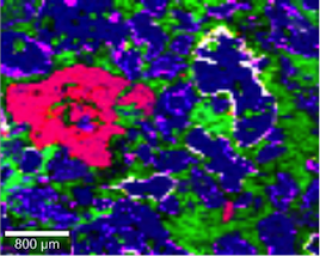
Image: Organic matter in a ca. 1,900 million years old hyaloclastite from Nunavut, Canada. This hydrothermal vent deposit is dominated by coarse carbonate (green), basalt glass shards (blue), and organic matter (red).
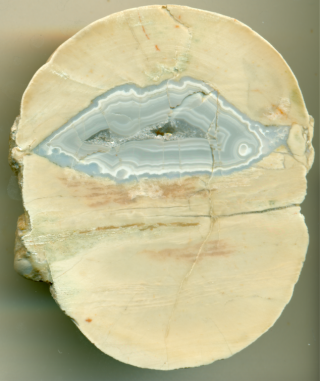 On the role of chemically-oscillating reactions during the diagenesis
On the role of chemically-oscillating reactions during the diagenesis

We are interested in determining the range of mineralogy of different diagenetic rosettes, granules, and concretions, because these sedimentological features formed inside the sediments and in association with decaying biomass. This project is done primarily by using optical microscopy, micro-Raman, and Focused Ion Beam. This latter technique consists in nano-fabricating correlative microscopic mineral assemblages with a Focused Ion Beam followed by Scanning Electron Microscopy and Energy Dispersive Spectroscopy to determine elemental compositions. The association of organic matter, sulphides, phosphates, and silicates with these structures then reveals how non-linear oscillating oxido-reduction reactions participate in fossilisation processes. In turn this will help to better understand the origin of stromatolites, concretions, and banded iron formations as well as their significance in mineral evolution.
Image: Limestone concretion with a geometrically-centred zone of agate, possibly from chemically-oscillating reactions.
What are the physical-chemical processes that participate in the formation of stromatolites and banded iron formation?
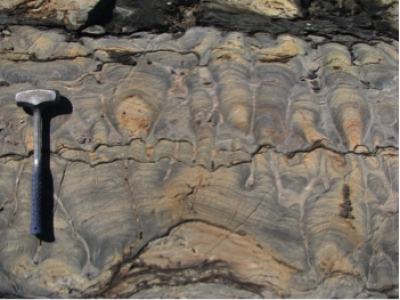
Through detailed petrographic studies of organic matter and mineralise reaction products of biomass, we aim to determine the origin of stromatolites. This includes studying the range of morphological structures and their stable isotope compositions in natural samples of modern and Precambrian stromatolites as well as from geochemical experiments. The goal is to explain the formation of diagenetic structures and minerals and conclusively elucidate the origin of these still mysterious rock types.
Image: Outcrop of a 1,900 million years old stromatolitic carbonate from Nunavut, Canada, which form decimeter-size columns on meter-sized turbinate domes. Similar 'bioherms' go back to about 3,500 million years ago and represent an important biosignature in exobiology.
How were the biogeochemical cycles of C, N, S, and P modulated by global tectonics, climate and oxygenation during the Neo- and Paleoproterozoic?
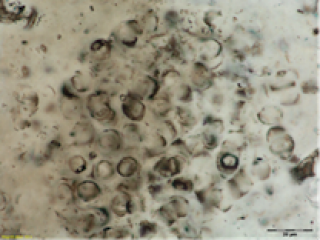
This research involves joint petrographic and in situ stable isotope analyses of C, N, and S as well as the co-related mapping of apatite and organic matter by micro-Raman. When integrated as such, these techniques collectively provide images of stable isotope compositions in the petrographic context of organic matter, apatite, carbonate, and sulphides. These minerals are possible products of the diagenetic oxidation of humic acids coupled to the reduction of sulphate, nitrate, and oxygen. These reactions can be performed by microbes or non-biologically, so the key is the co-occurrence with apatite [Ca5(PO4)3(OH,F,Cl)], which is a well-known biomineral occurring in bacteria as polyphosphate inclusions and in animals as teeth and bones. Secular occurrences of deposits that record notable stable isotope shifts ('excursions' or 'depletions') often occur in rift basins, glacial intervals, and/or red beds. Understanding how these processes relate to environmental oxygen production can shed light on predicting climate change, mineral evolution, the step-wise oxidation of Earth surface environments during Earth history, and the underlying driver of biological 'explosions'.
Image: Transmitted light image of a colony of coccoidal microfossils composed of organic matter mixed with pyrite (brown-black) in an apatite granule from the ca. 632 million years old phosphorite from Yichang, Hebei, China. Phosphorites are known to occur only during specific time periods in Earth history.
What signs of life to look for on Mars?
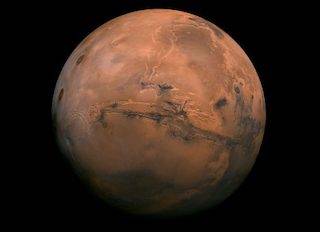
Image: Mosaic of the Valles Marineris hemisphere of Mars. Credit: NASA/JPL-Caltech
We also study the micro-paleontology of rocks from throughout Earth history
We investigate the occurrences of filamentous, spheroidal, and twisted structures that could potentially represent the remains of micro-organisms. We then investigate their minerology and compositions to determine whether these are consistent with a biological origin. Specimens come from a range of localities such as the modern acid mine drainage of the Rio Tinto in Spain and the 3.8 billion years old Nuvvuagittuq Supracrustal Belt in Canada.
What is the petrographic distribution of organic matter in meteorites?
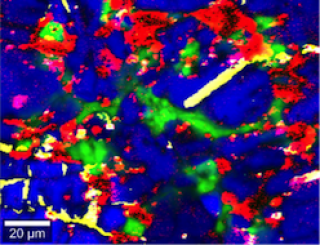
We are interested primarily in determining the minerals associated with organic matter in the petrographic context of olivine-pyroxene chondrules, Calcium-Aluminium inclusions, spinels, sulphides, phyllosilicates, and phosphides (e.g. schreibersite). Main analytical techniques for this work include optical microscopy, micro-Raman, and FIB-SEM-EDS. Because this organic matter has a non-biological origin, the minerals it is associated with could have catalysed oxido-reduction reactions and produce the organic matter.
Image: Raman hyperspectral image of a carbonate (green) globule in orthopyroxene matrix (blue) in the martian meteorite ALH84001. It also contains organic matter (red), iron oxides (purple), and contaminant epoxy (yellow) used in sample preparation.
Life in icy satellites
The outer solar system is host to many icy planetary bodies. These have rocky cores overlain by several hundred kilometres of ice, and can harbour deep global oceans of liquid water beneath brittle icy crusts as much as 100-200 km thick. These subsurface oceans in icy satellites represent possibly the largest habitable volume in the solar system, and perhaps the universe, and are an exciting target for astrobiological study - both by remote and in situ instrumentation, and by study of terrestrial analogues (e.g., Lakes Vostok and Ellsworth, under the Antarctic ice sheet). Furthermore, studies of bacterial growth in ice - either in natural glaciers or in high-pressure laboratory apparatus - lead us to believe that ecosystems may pervade the entire high-pressure ice shell of the largest outer solar system satellites. Saturn's largest icy moon, Titan, also stands out because of its thick nitrogen-methane atmosphere, the presence of liquid methane-ethane seas on its surface, and the generation of complex hydrocarbons and nitriles in the upper atmosphere. Whilst it is thought by many that these processes will aid in understanding prebiotic chemistry on the early Earth, others consider it plausible that life began (and persists) in the liquid methane on Titan's surface, living in reverse versions of the membranes used by cells on Earth.
Astrobiology and the Moon
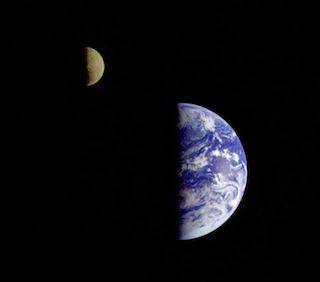
Image: The Earth and moon photographed together by the Galileo spacecraft. Credit: NASA/JPL
 Close
Close

